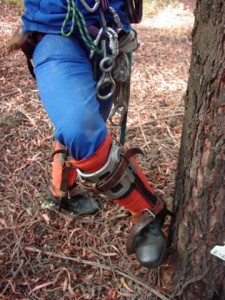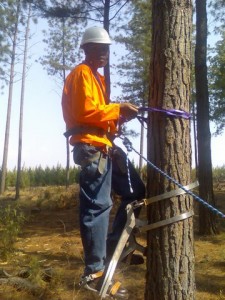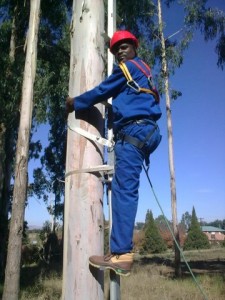Get trained in Forest Tree Climbing Skills
Full Course (2 days) R6400 p/p
Apply Basic Tree Climbing Principles.
Using either Tree Ladders or Tree Grippers (tree bicycles) or Climbing Spikes (climbing spurs)
- Risk assessment
- PPE
- Rope skills
- Ascending and descending
- Work positioning
- Fall arrest
- Equipment care and storage
This course requires 2 participants working as a team. One person as the climber and the other as the belayer/ rope manager. Full PPE must be used throughout the course. A practical and theoretical assessment is carried out including filling out a work book.
- Participants must be fit, agile and in good health.
- Certificates and climber’s cards are issued afterwards and are valid for 3 years.
- Forestry companies hold annual refresher courses R800 p/p.
Contact Gavin on gavin@peakhigh.co.za or 082 990 5876
We offer 3 main tree climbing courses to the commercial forestry industry. They all involve the use of some rope safety system and dynamic (stretchable) rope. The courses differ in how the climber ascends and descends the stem of the tree. The three ways are either with Tree-Climbing-Spikes, Tree-Bicycles or with Connecting ladders. Most climbing teams are trained in just one of these methods. The choice of the course depends on the needs of the client, the type of tree, the number of trees and productively level required.
Tree-Climbing-Spikes: This is the fastest and most productive way of getting the job done. It does however require the highest skill and fitness by the climber. It has a slightly higher risk factor and therefore requires the climbers to be kept in good training and to be extra diligent with their safety checks. It can be used in both commercial pine and Eucalyptus plantations. There is an added risk of infection to the tree due to the spikes penetrating the bark.
This is the fastest and most productive way of getting the job done. It does however require the highest skill and fitness by the climber. It has a slightly higher risk factor and therefore requires the climbers to be kept in good training and to be extra diligent with their safety checks. It can be used in both commercial pine and Eucalyptus plantations. There is an added risk of infection to the tree due to the spikes penetrating the bark.
Tree-Bicycles (tree grippers):
 This method uses two aluminum clamps which the climber straps around the stem and moves upwards while standing on them. It is a particularly useful and fast method for tall, straight saw-wood timber trees. The clamps work best on the rough bark of pine trees but can also be used on Eucalyptus, if the bark is dry. It is best used on tall trees where the same tree is climbed for several years. This is because when it is first ascended, small branches have to be removed on the way up the stem, before the crown is reached. Once this is done, all subsequent ascents are much faster. This method has a high start up cost due to the high cost of Tree-Bicycle clamps.
This method uses two aluminum clamps which the climber straps around the stem and moves upwards while standing on them. It is a particularly useful and fast method for tall, straight saw-wood timber trees. The clamps work best on the rough bark of pine trees but can also be used on Eucalyptus, if the bark is dry. It is best used on tall trees where the same tree is climbed for several years. This is because when it is first ascended, small branches have to be removed on the way up the stem, before the crown is reached. Once this is done, all subsequent ascents are much faster. This method has a high start up cost due to the high cost of Tree-Bicycle clamps.
Connecting ladders: This method uses several ladders which are stacked on top of each other and at the same time are strapped to the tree. It is an easy method to lean, but is time consuming and has the lowest productivity level of all three methods. It is a useful method for climbing teams who do not climb often or need to climb only a few trees per year.
This method uses several ladders which are stacked on top of each other and at the same time are strapped to the tree. It is an easy method to lean, but is time consuming and has the lowest productivity level of all three methods. It is a useful method for climbing teams who do not climb often or need to climb only a few trees per year.
